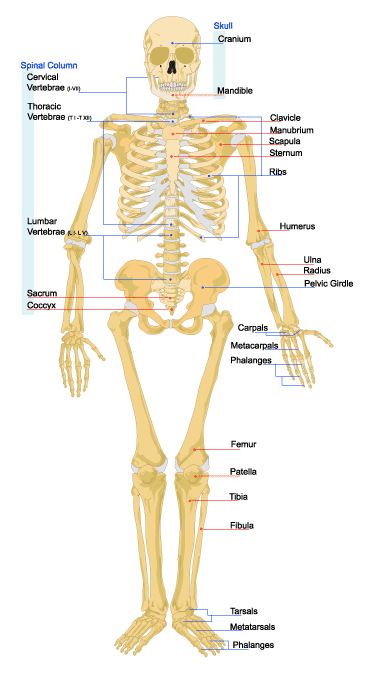13.33: Sistema esquelético
- Page ID
- 108277
\( \newcommand{\vecs}[1]{\overset { \scriptstyle \rightharpoonup} {\mathbf{#1}} } \)
\( \newcommand{\vecd}[1]{\overset{-\!-\!\rightharpoonup}{\vphantom{a}\smash {#1}}} \)
\( \newcommand{\dsum}{\displaystyle\sum\limits} \)
\( \newcommand{\dint}{\displaystyle\int\limits} \)
\( \newcommand{\dlim}{\displaystyle\lim\limits} \)
\( \newcommand{\id}{\mathrm{id}}\) \( \newcommand{\Span}{\mathrm{span}}\)
( \newcommand{\kernel}{\mathrm{null}\,}\) \( \newcommand{\range}{\mathrm{range}\,}\)
\( \newcommand{\RealPart}{\mathrm{Re}}\) \( \newcommand{\ImaginaryPart}{\mathrm{Im}}\)
\( \newcommand{\Argument}{\mathrm{Arg}}\) \( \newcommand{\norm}[1]{\| #1 \|}\)
\( \newcommand{\inner}[2]{\langle #1, #2 \rangle}\)
\( \newcommand{\Span}{\mathrm{span}}\)
\( \newcommand{\id}{\mathrm{id}}\)
\( \newcommand{\Span}{\mathrm{span}}\)
\( \newcommand{\kernel}{\mathrm{null}\,}\)
\( \newcommand{\range}{\mathrm{range}\,}\)
\( \newcommand{\RealPart}{\mathrm{Re}}\)
\( \newcommand{\ImaginaryPart}{\mathrm{Im}}\)
\( \newcommand{\Argument}{\mathrm{Arg}}\)
\( \newcommand{\norm}[1]{\| #1 \|}\)
\( \newcommand{\inner}[2]{\langle #1, #2 \rangle}\)
\( \newcommand{\Span}{\mathrm{span}}\) \( \newcommand{\AA}{\unicode[.8,0]{x212B}}\)
\( \newcommand{\vectorA}[1]{\vec{#1}} % arrow\)
\( \newcommand{\vectorAt}[1]{\vec{\text{#1}}} % arrow\)
\( \newcommand{\vectorB}[1]{\overset { \scriptstyle \rightharpoonup} {\mathbf{#1}} } \)
\( \newcommand{\vectorC}[1]{\textbf{#1}} \)
\( \newcommand{\vectorD}[1]{\overrightarrow{#1}} \)
\( \newcommand{\vectorDt}[1]{\overrightarrow{\text{#1}}} \)
\( \newcommand{\vectE}[1]{\overset{-\!-\!\rightharpoonup}{\vphantom{a}\smash{\mathbf {#1}}}} \)
\( \newcommand{\vecs}[1]{\overset { \scriptstyle \rightharpoonup} {\mathbf{#1}} } \)
\( \newcommand{\vecd}[1]{\overset{-\!-\!\rightharpoonup}{\vphantom{a}\smash {#1}}} \)
\(\newcommand{\avec}{\mathbf a}\) \(\newcommand{\bvec}{\mathbf b}\) \(\newcommand{\cvec}{\mathbf c}\) \(\newcommand{\dvec}{\mathbf d}\) \(\newcommand{\dtil}{\widetilde{\mathbf d}}\) \(\newcommand{\evec}{\mathbf e}\) \(\newcommand{\fvec}{\mathbf f}\) \(\newcommand{\nvec}{\mathbf n}\) \(\newcommand{\pvec}{\mathbf p}\) \(\newcommand{\qvec}{\mathbf q}\) \(\newcommand{\svec}{\mathbf s}\) \(\newcommand{\tvec}{\mathbf t}\) \(\newcommand{\uvec}{\mathbf u}\) \(\newcommand{\vvec}{\mathbf v}\) \(\newcommand{\wvec}{\mathbf w}\) \(\newcommand{\xvec}{\mathbf x}\) \(\newcommand{\yvec}{\mathbf y}\) \(\newcommand{\zvec}{\mathbf z}\) \(\newcommand{\rvec}{\mathbf r}\) \(\newcommand{\mvec}{\mathbf m}\) \(\newcommand{\zerovec}{\mathbf 0}\) \(\newcommand{\onevec}{\mathbf 1}\) \(\newcommand{\real}{\mathbb R}\) \(\newcommand{\twovec}[2]{\left[\begin{array}{r}#1 \\ #2 \end{array}\right]}\) \(\newcommand{\ctwovec}[2]{\left[\begin{array}{c}#1 \\ #2 \end{array}\right]}\) \(\newcommand{\threevec}[3]{\left[\begin{array}{r}#1 \\ #2 \\ #3 \end{array}\right]}\) \(\newcommand{\cthreevec}[3]{\left[\begin{array}{c}#1 \\ #2 \\ #3 \end{array}\right]}\) \(\newcommand{\fourvec}[4]{\left[\begin{array}{r}#1 \\ #2 \\ #3 \\ #4 \end{array}\right]}\) \(\newcommand{\cfourvec}[4]{\left[\begin{array}{c}#1 \\ #2 \\ #3 \\ #4 \end{array}\right]}\) \(\newcommand{\fivevec}[5]{\left[\begin{array}{r}#1 \\ #2 \\ #3 \\ #4 \\ #5 \\ \end{array}\right]}\) \(\newcommand{\cfivevec}[5]{\left[\begin{array}{c}#1 \\ #2 \\ #3 \\ #4 \\ #5 \\ \end{array}\right]}\) \(\newcommand{\mattwo}[4]{\left[\begin{array}{rr}#1 \amp #2 \\ #3 \amp #4 \\ \end{array}\right]}\) \(\newcommand{\laspan}[1]{\text{Span}\{#1\}}\) \(\newcommand{\bcal}{\cal B}\) \(\newcommand{\ccal}{\cal C}\) \(\newcommand{\scal}{\cal S}\) \(\newcommand{\wcal}{\cal W}\) \(\newcommand{\ecal}{\cal E}\) \(\newcommand{\coords}[2]{\left\{#1\right\}_{#2}}\) \(\newcommand{\gray}[1]{\color{gray}{#1}}\) \(\newcommand{\lgray}[1]{\color{lightgray}{#1}}\) \(\newcommand{\rank}{\operatorname{rank}}\) \(\newcommand{\row}{\text{Row}}\) \(\newcommand{\col}{\text{Col}}\) \(\renewcommand{\row}{\text{Row}}\) \(\newcommand{\nul}{\text{Nul}}\) \(\newcommand{\var}{\text{Var}}\) \(\newcommand{\corr}{\text{corr}}\) \(\newcommand{\len}[1]{\left|#1\right|}\) \(\newcommand{\bbar}{\overline{\bvec}}\) \(\newcommand{\bhat}{\widehat{\bvec}}\) \(\newcommand{\bperp}{\bvec^\perp}\) \(\newcommand{\xhat}{\widehat{\xvec}}\) \(\newcommand{\vhat}{\widehat{\vvec}}\) \(\newcommand{\uhat}{\widehat{\uvec}}\) \(\newcommand{\what}{\widehat{\wvec}}\) \(\newcommand{\Sighat}{\widehat{\Sigma}}\) \(\newcommand{\lt}{<}\) \(\newcommand{\gt}{>}\) \(\newcommand{\amp}{&}\) \(\definecolor{fillinmathshade}{gray}{0.9}\)
El sistema esquelético consiste en todos los huesos del cuerpo. ¿Qué importancia tienen tus huesos?
Intenta imaginar cómo te verías sin ellos. Serías una pila suave y tambaleante de piel, músculos y órganos internos, así que podrías parecer algo así como una babosa muy grande. No es que puedas verte a ti mismo, pliegues de piel caerían sobre tus ojos y bloquearían tu visión debido a tu falta de huesos del cráneo. Podrías sacar la piel del camino, si solo pudieras mover los brazos, ¡pero también necesitas huesos para eso!
El Esqueleto
El esqueleto humano es un marco interno que, en adultos, consta de 206 huesos, la mayoría de los cuales se muestran en la Figura siguiente.
Además de los huesos, el esqueleto también consiste en cartílago y ligamentos:
- El cartílago es un tipo de tejido conectivo denso, hecho de fibras proteicas resistentes, que proporciona una superficie lisa para el movimiento de los huesos en las articulaciones.
- Un ligamento es una banda de tejido conectivo fibroso que mantiene los huesos unidos y los mantiene en su lugar.
 El esqueleto humano consiste en huesos, cartílagos y ligamentos.
El esqueleto humano consiste en huesos, cartílagos y ligamentos. El esqueleto sostiene el cuerpo y le da forma. También tiene varias otras funciones, entre ellas:
- proteger los órganos internos
- proporcionar superficies de fijación para los músculos
- producir células sanguíneas
- almacenamiento de minerales
- mantener la homeostasis mineral.
Mantener la homeostasis mineral es una función muy importante del esqueleto, porque solo se necesitan los niveles adecuados de calcio y otros minerales en la sangre para el funcionamiento normal del cuerpo. Cuando los niveles minerales en la sangre son demasiado altos, los huesos absorben algunos de los minerales y los almacenan como sales minerales, razón por la cual los huesos son tan duros. Cuando los niveles sanguíneos de minerales son demasiado bajos, los huesos liberan algunos de los minerales de nuevo a la sangre, restaurando así la homeostasis.
Viernes de Ciencia: Salto en Jerboas
Los jerboas son criaturas adorables que son capaces de saltar hasta tres pies. En este video de Science Friday, el Dr. Kim Cooper revela cómo los huesos de las piernas extremadamente flexibles de las jerboas lo hacen posible, y las implicaciones que podría tener para el crecimiento óseo humano.
Resumen
- El esqueleto humano adulto incluye 206 huesos y otros tejidos.
- El esqueleto sostiene el cuerpo, protege los órganos internos, produce células sanguíneas y mantiene la homeostasis mineral.
Revisar
- ¿Qué es el cartílago? ¿Cuál es su papel en el sistema esquelético?
- Enumerar tres funciones del esqueleto humano.
- Explicar cómo los huesos mantienen la homeostasis mineral en el cuerpo.
| Imagen | Referencia | Atribuciones |
 |
[Figura 1] | Crédito: Mariana Ruiz Villarreal (Usuario:Ladyofhats/Wikimedia Commons) Fuente: Commons.wikimedia.org/wiki/Archivo:Human_Skeleton_front_es.svg Licencia: Dominio público |
 |
[Figura 2] | Crédito: Mariana Ruiz Villarreal (Usuario:Ladyofhats/Wikimedia Commons) Fuente: Commons.wikimedia.org/wiki/Archivo:Human_Skeleton_front_es.svg Licencia: Dominio público |

